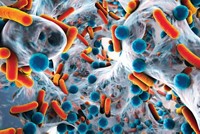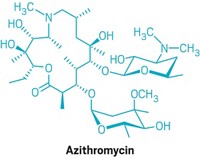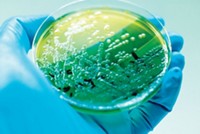Advertisement
Grab your lab coat. Let's get started
Welcome!
Welcome!
Create an account below to get 6 C&EN articles per month, receive newsletters and more - all free.
It seems this is your first time logging in online. Please enter the following information to continue.
As an ACS member you automatically get access to this site. All we need is few more details to create your reading experience.
Not you? Sign in with a different account.
Not you? Sign in with a different account.
ERROR 1
ERROR 1
ERROR 2
ERROR 2
ERROR 2
ERROR 2
ERROR 2
Password and Confirm password must match.
If you have an ACS member number, please enter it here so we can link this account to your membership. (optional)
ERROR 2
ACS values your privacy. By submitting your information, you are gaining access to C&EN and subscribing to our weekly newsletter. We use the information you provide to make your reading experience better, and we will never sell your data to third party members.
Antibiotics
Gallium can make MRSA biofilms more susceptible to antibiotics
The metallic element breaks down bacterial defenses to make vancomycin more effective at lower doses
by Benjamin Plackett, special to C&EN
August 25, 2021

Biofilms—communities of bacteria living within a slimy matrix of their own making—account for roughly 80% of hospital-acquired infections. Antibiotic-resistant diseases already kill about 700,000 people annually, and that figure could swell to 10 million by 2050 if the problem is not addressed, according to a 2019 report by the Interagency Coordination Group on Antimicrobial Resistance, a group convened by the United Nations secretary general. However, a new study offers an approach to combat biofilms using a combination of two gallium-based drugs to render bacterial colonies more susceptible to antibiotics (ACS Infect. Dis. 2021, DOI: 10.1021/acsinfecdis.1c00280).
The structure of a fully developed biofilm and the contents of its extracellular matrix make the resident bacteria much more resilient against drugs. Individual bacterial cells and immature biofilms, by comparison, are not so strong. That’s why orthopedic surgeons Zubin Zhou and Xiaowei Yu of Shanghai Jiao Tong University and Shanghai Sixth People’s Hospital wanted to find out if biofilms are easier to kill with existing antibiotics once their structures are degraded.
“I see too many patients with really bad infections, and sometimes they have to lose their legs or arms,” Zhou says. “This research might provide a novel basis for future biofilm treatments so that doesn’t need to happen as often.”
The researchers cultured mature methicillin-resistant Staphylococcus aureus (MRSA) biofilms and then later administered gallium protoporphyrin and gallium nitrate, the latter of which is approved by the US Food and Drug Administration to treat cancer-associated hypercalcemia. Gallium has been proposed as an antimicrobial agent because it interrupts bacteria’s iron uptake—resulting in nutritional starvation. Previous studies have shown that the combination of these two gallium compounds is particularly potent, likely because they target different parts of a bacteria’s iron metabolism.
Two days after gallium treatment, Zhou and Yu observed that the biofilms’ structures resembled that of immature biofilms. Zhou and Yu were then able to kill off the gallium-treated biofilms with vancomycin, the antibiotic commonly deployed against MRSA, at one-tenth the dose ordinarily needed to destroy a biofilm. This means that gallium could help reduce the spread of antibiotic resistance by allowing lower doses of vancomycin to be used to treat infections.
Katharina Richter of the University of Adelaide cautiously welcomed the findings. She recognizes that the group succeeded in making the biofilms more susceptible to treatment but points out that it could be some time before this technique is used in clinical practice. “It was all done in vitro, but I’d love to see some animal studies,” she says. “Biofilms also have a lot of variation; every biofilm is different to some extent, and so it’s going to be hard to replicate results.”





Join the conversation
Contact the reporter
Submit a Letter to the Editor for publication
Engage with us on Twitter